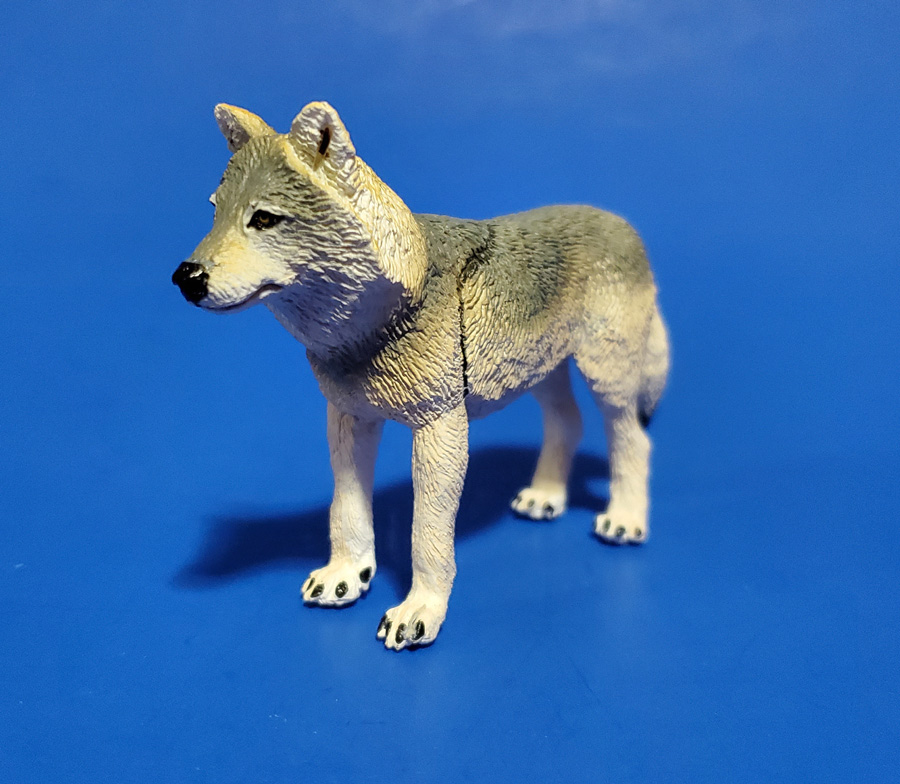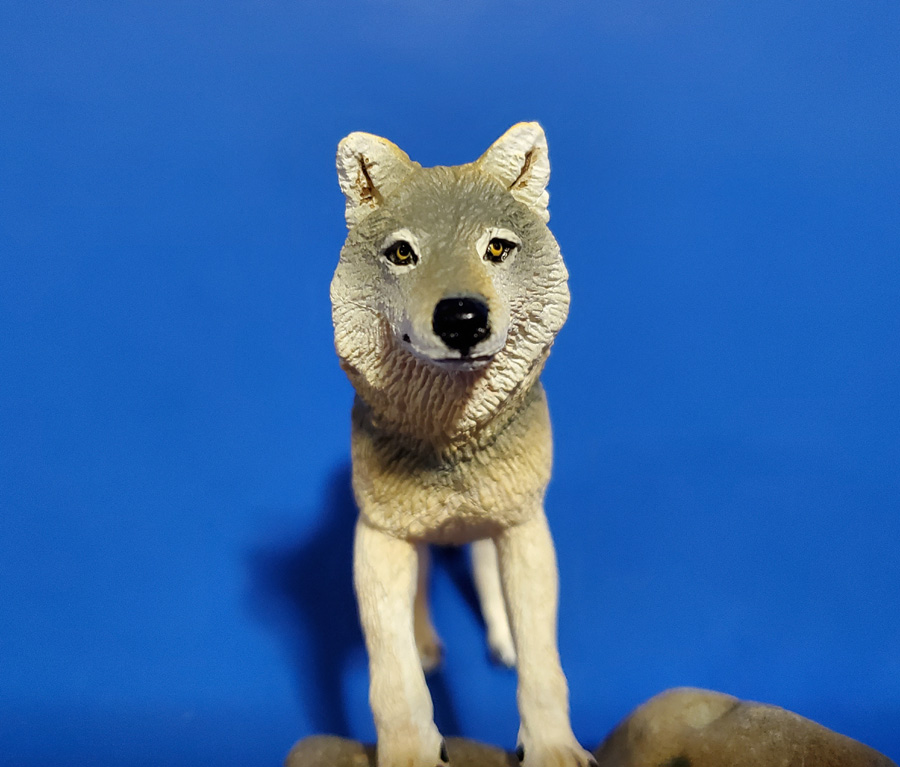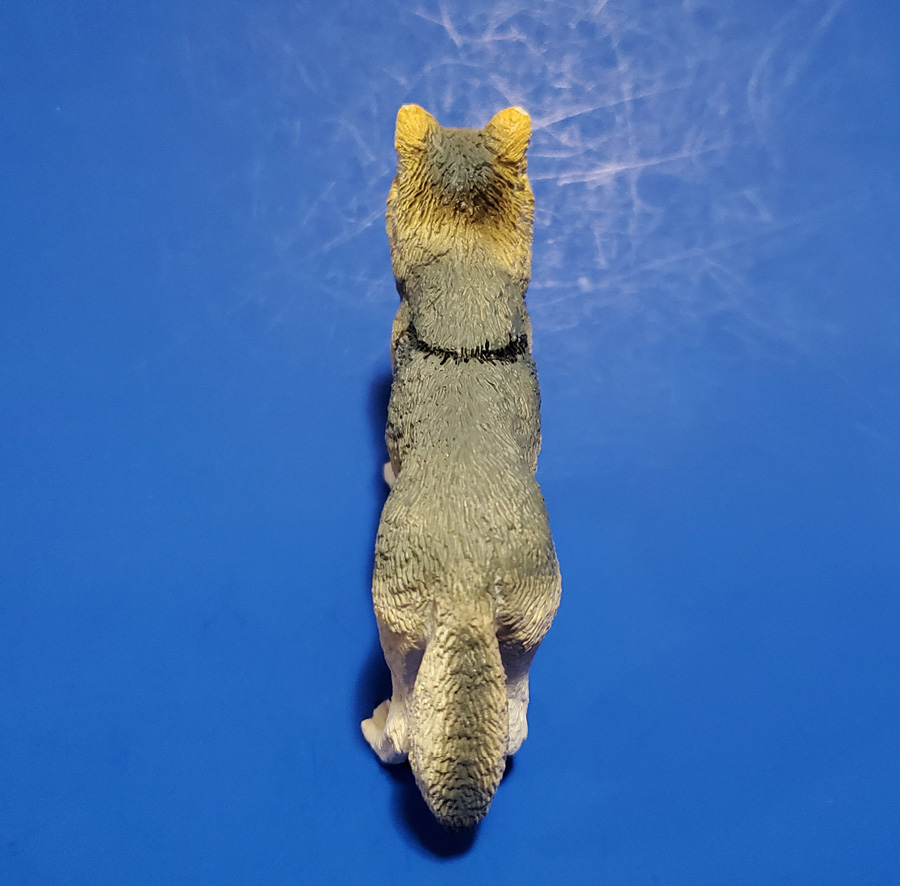Review and images by Saarlooswolfhound; edited by bmathison1972
The Safari Ltd. Gray Wolf, #100509 was released as part of their 2020 additions. It is included in their Wild Safari North American Wildlife Collection. The model itself measures as 4 inches (10 cm) long and around 2.75 inches (7 cm) tall (roughly the size of a credit card standing on its long edge, or roughly 1:9.5 – 1:12.5 in scale). Where this wolf lacks in dynamism it makes up for in detail!

While a specific variety is not included with this figure, a collector could describe it as nearly any gray-colored variety of North American gray wolf they wish. These animals are highly family-oriented and are essential parts of the ecosystem in which they live, providing top down predation that keeps populations in control and the ecosystem balanced. Gray wolf varieties include Arctic, northwestern, plains, coastal, Mexican, tundra, Tibetan/Himalayan, Iberian, Italian, Eurasian, Persian/Indian, Arabian, red, and eastern wolves. While the more arid-adapted types appear more coyote- or jackal-like, temperate species all retain characteristics that most people think of when picturing a gray wolf. Gray wolves are, as you can see, one of the most diverse species on the planet and have a remarkable ability to adapt to new niches and environments. Even extreme places such as the surrounding area of the Chernobyl meltdown and other abandoned human residences.

All wolves pups are born darkly-colored with blue eyes, and as they mature will develop their gray-patterned coats and iconic yellow eyes. Families can be variable, but a typical gray wolf pack consists of a dominant pair that has exclusive breeding rights and their offspring from various litters. Older pups assist in rearing youngsters, and this cycle continues until the dominant pair is eliminated in some fashion (injury, accident, circumstance, or natural old age) at which time pack members usually disperse and join other packs if possible or join with other individuals and start a new group. These animals have been controversial in the past and continue to be today, many governments labeling them as nuisances and pests for the livestock industry. In the United States, several varieties of gray wolf were sent into extinction due this issue, which wreaked havoc in many environments. In 1996, Yellowstone National Park headed up an endeavor to reintroduce a Canadian variety into the park, which has been quite successful. Today, surrounding areas have also had wolves reestablish and though they maintain their divisive status among residents, many people enjoy having these animals returned to their natural landscape.

Sculpted to be male, the facial structure of this animal is broad and squarer than most historical representations of wolves tend to be. For me, this lends it a more realistic quality as it does not present the pointed mustelid-style qualities of some other figures. His posture is relaxed and calm, like a sentinel watching quietly from the fringe of the forest. Fur detailing is exceptional, not too exaggerated but rather a smoother finish, utilizing proper angulation of fur details such as the ruff around the face and contours of the legs. Paint work is also exceptional, perhaps the most realistic in terms of pattern and details noticed in real specimens. Gray on upper portions if the coat all along its dorsal side, counter shaded and lighter along the sides and ventral portions of the model. An attempt at the dark strip of fur that wraps around from shoulder to shoulder to demarcate the “mane”-like guard hairs of the neck as they move into the back and hindquarters, perhaps not painted expertly, but I appreciate the inclusion of the detail. Standard yellow eyes of an adult, dark nails including a dewclaw, toepads, dark tail tip, are all aspects that further lend a sense of quality to the figure as a whole.

Disclaimer: links to Ebay and Amazon on the AnimalToyBlog are affiliate links, so we make a small commission if you use them. Thanks for supporting us!




Spectacular! When I first built my Syntoptic Collection, I had the 2007 Safari howling gray wolf. When I saw this, I thought I would replace it. Then I thought I wouldn’t. But then, when the first reviews showed up on the STS forum, I decided to get it! I am glad I did!
I agree the pose is a bit static; like the Safari dingo it kinda suffers from the effect of looking like a taxidermied specimen in a museum. However, as pointed out in this review, what it loses with the pose it more than makes up for in sculpt and paint!!!
If wolves are in your collection, I highly recommend this one!
It’s nice how the blog now features wolves in black, white, and grey.
yeah, it took 6 ‘Canis lupus’ reviews to get the original gray stock 😀